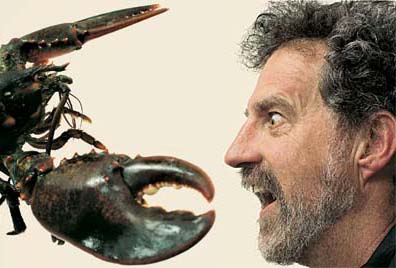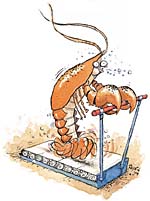 |
 |
| current issue |  |
past issues |  |
send a letter/news |  |
address update |  |
advertise |  |
about us |  |
alumni home |
Features
Crustaceans with AttitudeLobsters can be combative, agile and surprisingly tender (and not just to eat)
by Virginia Stuart '75, '80G

In Win Watson's zoology lab there lurks a creature named Pinchy II. The six-inch-long baby lobster lives by herself in an aquarium where she peers out from beneath a rock. Whenever someone approaches her tank, she marches up to the glass and raises her open claws in a threatening display of miniature pinching power. This behavior is no random occurrence. No matter how many times a visitor returns to the tank, the baby lobster pops out of the shadows, showing off her bulging claws and forearms just above a sign that reads: Beware Attack Lobster.
The lobsters we think we know -- denizens of dark, dank grocery-store tanks, piled on top of each other and crammed into corners -- actually behave quite differently in other settings. In the lab, they have what it takes to walk a treadmill or negotiate a simple maze. In the wild, they joust like little knights, bury their food, and mate with amazing tenderness and abandon. Yet there is still much to learn. When it comes to how the animal behaves in its environment, says Watson, a UNH professor of zoology, "we really know squat."
The life of the lobster has been shrouded in mystery for years -- and for years, the lobster fishermen liked it that way. Dan Millar '78, who has been lobstering out of a craggy peninsula in Casco Bay, Maine, for the past 24 years, understands the urge to be secretive. "I'll tell you how many traps I have if you tell me how old you are," he once told a curious tourist. She got the point. Now that Maine lobstermen -- and women -- are limited to 800 traps apiece, that number is public knowledge, but other information remains well guarded. Millar knows lobstermen who would fire an employee who divulged the day's catch.

|
A zoologist by training, Millar has recently divided his time between lobstering and a job monitoring Maine's salmon-farming industry. He knows how frustrating it can be for scientists when fishermen refuse to share information that could be used to preserve the fishery. But among lobstermen, he explains, "there's always the feeling that scientists are out to prove there's a problem and cut me back."
The lobstermen have a point. Over the past 100 years, scientific models have repeatedly predicted the collapse of the lobster population in New England. Lobster landings remained steady for most of that time, and in the past 20 years, tripled from 20 to 60 million pounds a year in Maine alone. Reassuring? Perhaps. Then again, fish like cod and haddock also saw an increase in catch shortly before those populations collapsed. Moreover, the lobster populations off Long Island, Rhode Island and Connecticut have already gone into a slump. As much as they may hate the word "sustainable," many lobstermen are worried. Some have even begun collecting data for scientists they trust.
Win Watson is one of those scientists. "I tell my students this research is like working on a big jigsaw puzzle," he says. "All we can be expected to do is add a couple of pieces. And it would be really cool if we can find edge pieces or a corner piece and set some limits." As a zoologist with a specialization in neurobiology, he tends to ask basic questions: Can a lobster find its way home? Where and why does it migrate? Can lobsters communicate with each other? How do they behave around lobster traps? The answers to those questions could shed some light on the behavior of Pinchy and her kind, while helping scientists and lobstermen preserve a very valuable -- and delectable -- resource that is critical to the livelihood of thousands of New England families and a whole way of life in coastal communities.
The Lobster Ponderosa
Lobstermen call them "bugs of the ocean," and as arthropods -- jointed creatures with exoskeletons -- lobsters are related to insects. Clumsy on land and sluggish in tanks, they don't seem particularly capable. But venture down 20 feet below the surface of the ocean with zoology graduate student Darren Scopel, and the tables are turned. Encumbered by 100 pounds of diving equipment, Scopel moves slowly. He can hear only the rhythmic rush of exhaled bubbles, can see little beyond 10 feet away, and often has to use a compass to figure out which way is which.
The lobsters, on the other hand, dance like marionettes on strings, waltzing about on their many tiptoes. Acutely aware of their environment, a group of them sense Scopel's presence and turn toward him. One lobster marches up to Scopel's video camera, and lifting its heavy claws, raps twice on the camera housing.
Watson, who also studies the lowly sea slug, believes we underestimate many species, and he has been first to demonstrate some of the lobster's abilities. He is known for being a prankster, and some of the experiments and gadgets he's rigged up with the help of duct tape and Superglue almost sound like practical jokes. He devised a mini-treadmill to study lobster locomotion, for example, and a lobster heart monitor. It's not a lobster stress test, but a way of identifying some of the things, like a change in water temperature or salinity, that are so exciting or alarming to a lobster that its heart stops beating momentarily. His latest improbable-sounding experiment has two of his students, master's candidate Heidi Pye and Ben Winslow '04, spending hours every month holding lobsters at a lobster pound to try to figure out why roughly one out of every 10 lobsters will buzz when handled. Pye has also used the heart monitor to discover that a lobster's heart will skip a beat when it hears the sound of a tankmate buzzing.
 Courtesy of Darren Scopel |
Easy to print version
blog comments powered by Disqus

